Junior Web Designer Interview Questions
Landing your first job as a junior web designer means showing a good grasp of design tools, technical ability, problem-solving, creativity, and teamwork. This blog will help you prepare for a range of questions, including technical, analytical, and behavioral, that are common in junior-level interviews.
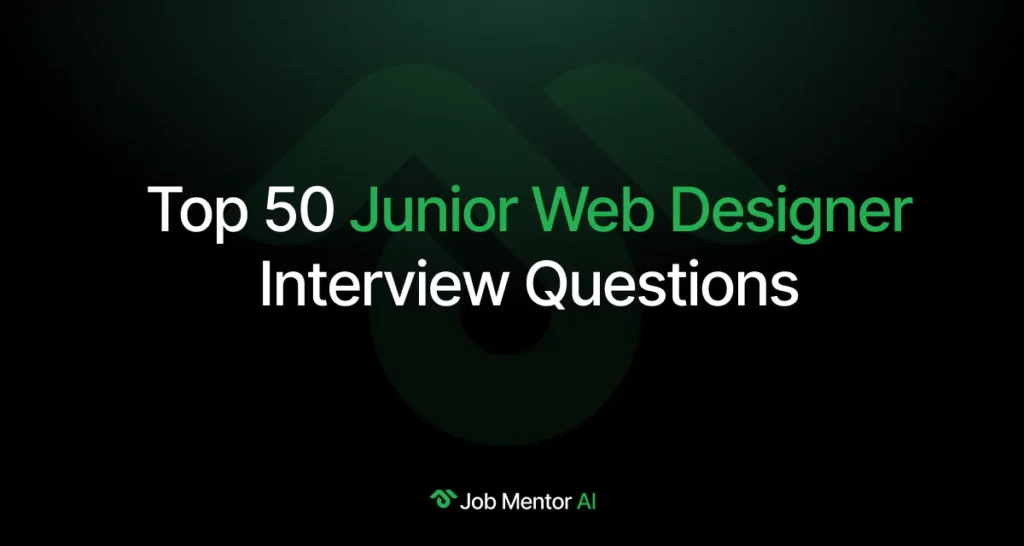
Introductory Phase (About You)
1. Can you introduce yourself?
2. Why did you choose frontend development as a career?
3. What excites you most about this role?
4. What are your strengths as a developer?
5. What do you enjoy doing outside of work or studies?
Background and Experience
1. Have you worked on any projects? Can you describe one?
2. Have you worked on websites or apps before? What was your role?
3. What is a frontend feature you’re most proud of building?
4. What tools have you used for web design or development?
5. How do you stay updated with the latest frontend trends?
Technical/Tools Expertise Web Designer Interview Questions
1. What do you know about HTML, CSS, and JavaScript?
2. Can you explain the difference between block, inline, and inline-block elements?
3. What is the difference between classes and IDs in CSS?
4. How do you make a website responsive?
5. Have you worked with any JavaScript libraries or frameworks?
Behavioral and Situational Web Designer Interview Questions
1. How do you handle tight deadlines?
2. What would you do if a client requested last-minute design changes?
3. How do you handle feedback on your designs or code?
4. Describe a time when you worked as part of a team.
5. What would you do if you discovered a major bug close to a deadline?
Critical Thinking Web Designer Interview Questions
1. How would you design a simple landing page?
2. What steps would you take to debug a broken layout?
3. How do you decide when to use custom CSS versus a framework?
4. What would you do if your website wasn’t mobile-friendly?
5. How would you approach improving a website’s loading speed?
Performance-Based Interview Questions for Web Designers
1. Can you create a simple webpage layout with HTML and CSS?
2. How would you fetch and display data from an API?
3. Can you explain and debug a piece of given code?
Problem-Solving and Analytical Thinking
1. What would you do if a database query took too long to execute?
2. How would you reduce wasted spend in a PPC campaign?
3. What steps would you take to fix a corrupted data file?
4. How do you ensure scalability in your data engineering solutions?
5. What would you do if your data pipeline introduced duplicate records?
Problem-Solving and Analytical Thinking in Web Designer Interview Questions
1. What would you do if your design wasn’t user-friendly?
2. How do you handle conflicting design feedback from clients and stakeholders?
3. What steps would you take to improve a slow-loading website?
4. How do you ensure a website design is accessible?
5. What would you do if a user couldn’t navigate your website easily?
Introductory Phase (About You)
Interviewers focus on your educational background and your motivation for pursuing web design to see how you fit the role in their company. These questions give you a chance to show enthusiasm about the job and your ability to fit within the company culture. Discussed below are some questions to ask a web designer about themselves in an interview.
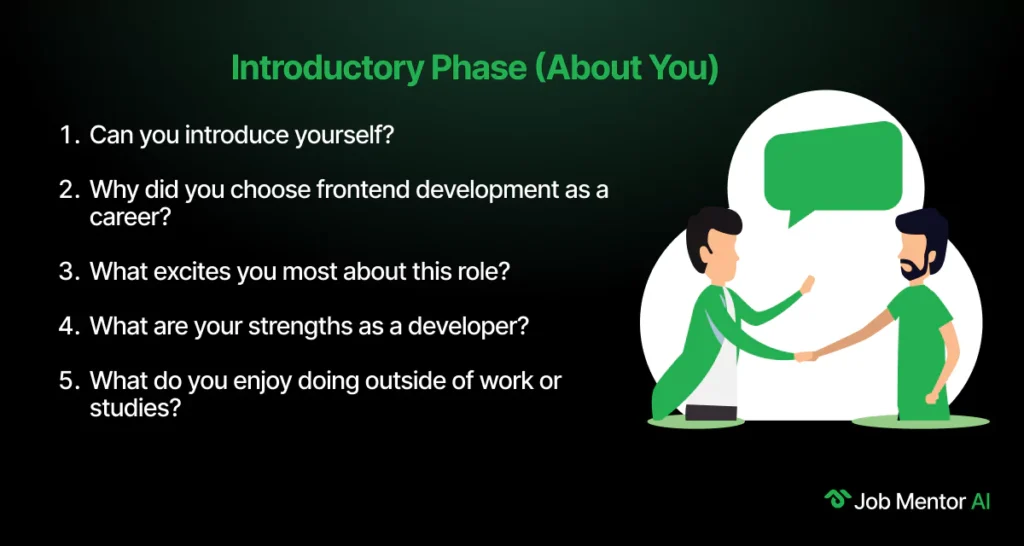
1. Can you introduce yourself?
What Interviewers Want:
A concise summary of educational background, interest in frontend development, and any relevant skills or experiences.
Strong Answer:
“I recently graduated with a degree in Computer Science and have been focusing on frontend development for the past two years. I’ve built projects using HTML, CSS, JavaScript, and React, including a personal portfolio and a dynamic to-do list app. I’m passionate about creating user-friendly interfaces and excited to bring my skills and enthusiasm to your team.”
Poor Answer:
“I studied Computer Science and have some experience in frontend development. I’ve worked on a few projects and am looking for a role to gain more experience.”
2. Why did you choose frontend development as a career?
What Interviewers Want:
A clear reason demonstrating passion for building user interfaces or a creative approach to solving problems.
Strong Answer:
“I enjoy combining creativity with problem-solving, and frontend development allows me to bring designs to life. I find it rewarding to create interfaces that are both visually appealing and easy to use, improving the overall user experience.”
Poor Answer:
“I like coding and designing, so frontend development seemed like a good choice.”
3. What excites you most about this role?
What Interviewers Want:
Genuine enthusiasm for the company’s projects, team, or tech stack.
Strong Answer:
“I’m excited about the opportunity to work on innovative projects with a team that values creativity and user experience. I admire the company’s focus on cutting-edge technologies and am eager to contribute while learning from experienced developers.”
Poor Answer:
“I’m excited to work with your team and improve my skills in frontend development.”
4. What are your strengths as a developer?
What Interviewers Want:
Confidence in skills like creativity, attention to detail, and willingness to learn.
Strong Answer:
“My strengths include attention to detail, creativity, and a quick learning ability. For example, I recently learned React to build a dynamic portfolio website, which taught me how to manage components and improve user interactivity.”
Poor Answer:
“My strengths are being detail-oriented, creative, and a fast learner.”
5. What do you enjoy doing outside of work or studies?
What Interviewers Want:
Hobbies or activities that may reflect creativity, problem-solving, or teamwork.
Strong Answer:
“In my free time, I enjoy experimenting with personal coding projects to sharpen my skills and staying updated on tech trends by reading blogs and watching tutorials. I also enjoy sketching, which helps me think creatively, and playing strategy games, which enhance my problem-solving abilities.”
Poor Answer:
“I spend my free time coding, learning about technology, and doing creative things like drawing.”
Background and Experience
Expect to be asked about your entire journey of web design by recruiters. Employers are interested in your journey, internship, coursework, and freelance projects. Below are some suggestions on how to tackle a few questions about your background and experience.
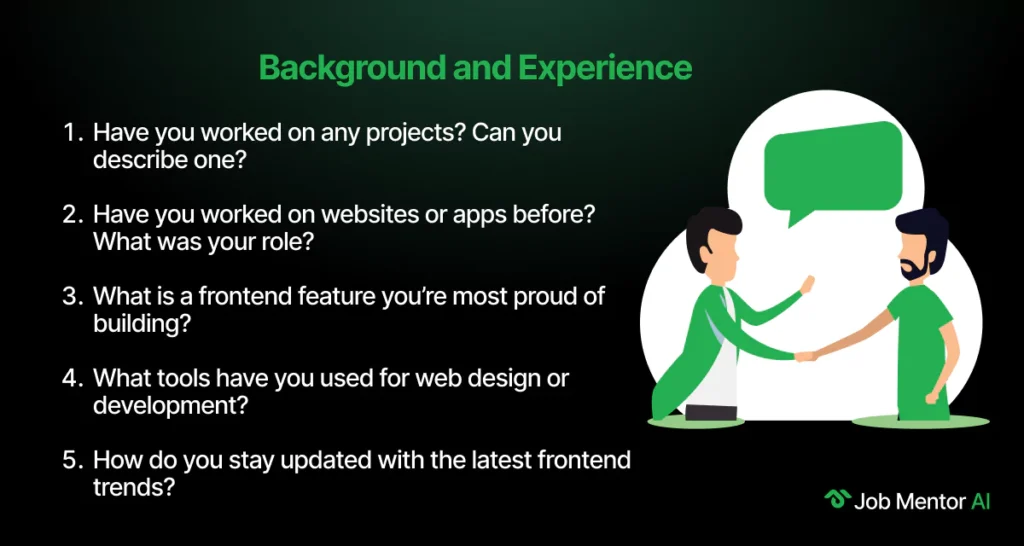
1. Have you worked on any projects? Can you describe one?
What Interviewers Want:
Examples of hands-on experience, including technologies used and challenges faced.
Strong Answer:
“Yes, I built a responsive portfolio website using HTML, CSS, and JavaScript. The site showcases my projects with an interactive gallery and includes a contact form with validation. One challenge was ensuring it looked consistent across devices, which I addressed using CSS media queries and thorough testing on different screen sizes.”
Poor Answer:
“I built a portfolio website using HTML, CSS, and JavaScript, and it has a contact form.”
2. Have you worked on websites or apps before? What was your role?
What Interviewers Want:
Clarity on individual contributions and experience with building interfaces.
Strong Answer:
“I worked on a team project to develop a task management app. My role was to design and implement the frontend using React, focusing on creating reusable components and integrating APIs for dynamic updates. I collaborated closely with the backend team to ensure seamless functionality.”
Poor Answer:
“I worked on the frontend of a task management app and added features like a task list.”
3. What is a frontend feature you’re most proud of building?
What Interviewers Want:
Passion for delivering visually appealing or functional components.
Strong Answer:
“I’m most proud of building a dynamic search bar for an e-commerce site. The feature provided real-time filtering of products as users typed, improving the shopping experience. I used vanilla JavaScript for DOM manipulation and optimized the logic to handle a large dataset efficiently.”
Poor Answer:
“I built a search bar for an e-commerce site that filtered products as users typed.”
4. What tools have you used for web design or development?
What Interviewers Want:
Familiarity with tools like VS Code, browser developer tools, or design software like Figma.
Strong Answer:
“I primarily use VS Code as my code editor, along with browser developer tools for debugging. For design, I’ve worked with Figma to create wireframes and prototypes. I also use Git for version control and platforms like Netlify for deployment.”
Poor Answer:
“I use VS Code for coding, browser tools for debugging, and Figma for design.”
5. How do you stay updated with the latest frontend trends?
What Interviewers Want:
A commitment to continuous learning, such as blogs, courses, or community participation.
Strong Answer:
“I follow industry blogs like Smashing Magazine and CSS-Tricks, watch tutorials on YouTube, and participate in forums like Dev.to and Stack Overflow. I also take online courses on platforms like freeCodeCamp to learn about new frameworks and best practices.”
Poor Answer:
“I read blogs and watch tutorials to learn about new trends in frontend development.”
Technical/Tools Expertise Web Designer Interview Questions
You’ll be asked about tools you’re familiar with, like Figma, Adobe, or basic front-end tech questions about HTML, CSS, and JavaScript frameworks. Explain in detail how you’ve implemented these technical concepts to perform tasks and drive results at your previous jobs or projects.
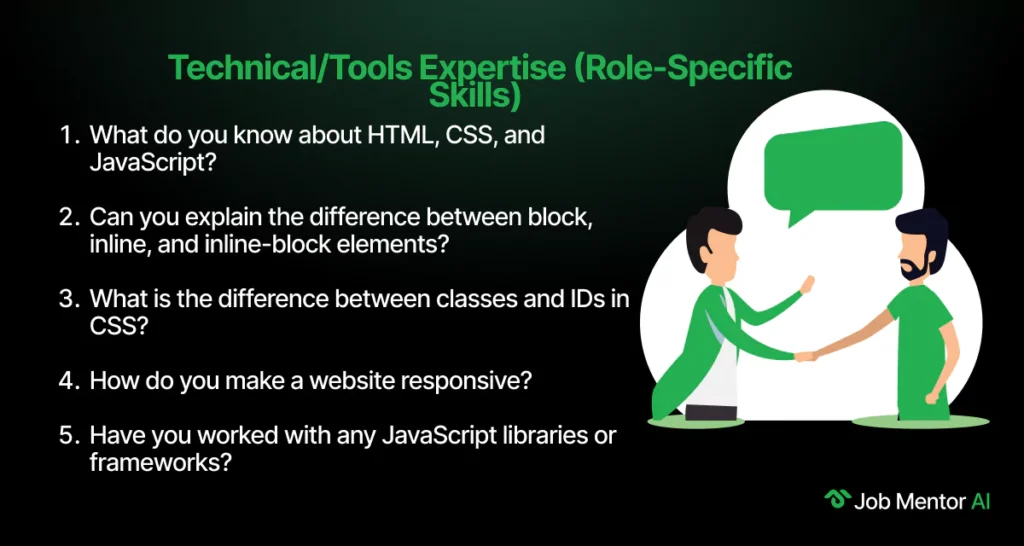
1. What do you know about HTML, CSS, and JavaScript?
What Interviewers Want:
A solid understanding of core technologies for frontend development.
Strong Answer:
“HTML provides the structure of a webpage using elements like headings, paragraphs, and links. CSS styles the content, allowing for layouts, colors, and responsiveness through techniques like Flexbox and Grid. JavaScript adds interactivity, such as handling user input, making API calls, and dynamically updating content. Together, they form the foundation of frontend development.”
Poor Answer:
“HTML is for structure, CSS is for styling, and JavaScript adds interactivity to web pages.”
2. Can you explain the difference between block, inline, and inline-block elements?
What Interviewers Want:
Knowledge of how elements behave in a layout.
Strong Answer:
“Block elements, like <div> and <p>, take up the full width of their container and start on a new line. Inline elements, like <span> and <a>, take up only as much width as their content and remain on the same line as surrounding elements. Inline-block elements, like <img>, behave like inline elements but allow setting width and height.”
Poor Answer:
“Block elements are full-width, inline elements are not, and inline-block is a mix of both.”
3. What is the difference between classes and IDs in CSS?
What Interviewers Want:
Understanding of their usage and specificity.
Strong Answer:
“Classes are reusable and can be applied to multiple elements, prefixed with a dot (.). IDs are unique and meant for a single element, prefixed with a hash (#). For example, you’d use a class to style all buttons consistently and an ID for a specific header.”
Poor Answer:
“Classes are for multiple elements, and IDs are for single elements.”
4. How do you make a website responsive?
What Interviewers Want:
Awareness of techniques like media queries, flexible layouts, and frameworks.
Strong Answer:
“I use CSS media queries to apply styles based on screen size and ensure layouts are flexible with Grid or Flexbox. I also use relative units like percentages or em for dimensions, and I test responsiveness on multiple devices using browser developer tools or platforms like BrowserStack.”
Poor Answer:
“I use media queries and test the site on different screen sizes to make it responsive.”
5. Have you worked with any JavaScript libraries or frameworks?
What Interviewers Want:
Experience with tools like React, Vue.js, or Angular.
Strong Answer:
“Yes, I’ve worked with React to build dynamic user interfaces. For example, I created a to-do app with state management using hooks. I’ve also used libraries like jQuery for DOM manipulation in earlier projects, but I focus on modern frameworks like React now.”
Poor Answer:
“I’ve used React and jQuery to build interactive websites.”
6. Can you explain the concept of the DOM?
What Interviewers Want:
An understanding of how browsers render and manipulate web pages.
Strong Answer:
“The DOM (Document Object Model) is a tree-like structure representing the HTML document. It allows JavaScript to interact with and manipulate elements, such as changing text, styles, or adding new content dynamically.”
Poor Answer:
“The DOM is how JavaScript interacts with elements on a web page.”
7. What is your experience with CSS frameworks?
What Interviewers Want:
Familiarity with tools like Bootstrap or Tailwind CSS.
Strong Answer:
“I’ve used Bootstrap to create responsive layouts quickly with its grid system and pre-designed components. I’ve also worked with Tailwind CSS, which offers a utility-first approach, allowing for more customization and flexibility.”
Poor Answer:
“I’ve used Bootstrap and Tailwind CSS to create websites.”
8. How do you optimize a webpage for performance?
What Interviewers Want:
Knowledge of techniques like minifying files, using a CDN, and image optimization.
Strong Answer:
“I optimize performance by compressing images, minifying CSS and JavaScript, reducing HTTP requests, and enabling lazy loading for media. Using a Content Delivery Network (CDN) and leveraging browser caching also helps. Tools like Lighthouse help identify specific areas for improvement.”
Poor Answer:
“I compress images, use caching, and minimize files to make the website faster.”
9. What is the difference between == and === in JavaScript?
What Interviewers Want:
Awareness of type coercion and strict equality in JavaScript.
Strong Answer:
“== checks for equality but allows type coercion, so ‘5’ == 5 evaluates to true. === checks for both value and type equality, so ‘5’ === 5 evaluates to false. Using === is recommended to avoid unexpected results due to type conversion.”
Poor Answer:
“== compares values, and === compares both values and types.”
10. How do you handle browser compatibility issues?
What Interviewers Want:
A process for testing and debugging on multiple browsers.
Strong Answer:
“I test the website on multiple browsers using tools like BrowserStack or browser developer tools. I use CSS resets and ensure cross-browser compatibility by avoiding non-standard code. For unsupported features, I implement polyfills or fallback solutions.”
Poor Answer:
“I test the website on different browsers and fix any issues I find.”
11. What tools have you used for debugging frontend issues?
What Interviewers Want:
Familiarity with browser developer tools and debugging techniques.
Strong Answer:
“I use browser developer tools to inspect elements, debug JavaScript, and monitor network requests. For example, I use the console to check for errors and set breakpoints in the debugger to identify and resolve issues.”
Poor Answer:
“I use browser tools to debug and fix issues on the frontend.”
12. What is the difference between absolute, relative, and fixed positioning in CSS?
What Interviewers Want:
Understanding of how positioning works in web layouts.
Strong Answer:
“Relative positioning moves an element relative to its normal position, absolute positioning places an element relative to its nearest positioned ancestor, and fixed positioning places an element relative to the viewport, so it stays in place during scrolling.”
Poor Answer:
“Relative positioning moves an element, absolute is based on its container, and fixed stays in place.”
13. What are pseudo-classes and pseudo-elements in CSS?
What Interviewers Want:
Knowledge of advanced CSS features for styling.
Strong Answer:
“Pseudo-classes target an element based on its state, like :hover for when a user hovers over an element. Pseudo-elements target specific parts of an element, like ::before to add content before an element. For example, p::before can insert text before a paragraph.”
Poor Answer:
“Pseudo-classes style elements based on their state, and pseudo-elements style specific parts of elements.”
14. Have you worked with APIs? How do you fetch data from one?
What Interviewers Want:
Practical understanding of using fetch, axios, or async/await.
Strong Answer:
“Yes, I’ve worked with APIs using the fetch method in JavaScript. For example, I fetched data from a weather API, processed the JSON response, and displayed the weather information dynamically on a webpage. I also handle errors using try-catch blocks with async/await.”
Poor Answer:
“I use the fetch method to get data from APIs and display it on the webpage.”
15. Can you explain CSS specificity?
What Interviewers Want:
Understanding of how CSS rules are applied when there are conflicts.
Strong Answer:
“CSS specificity determines which rule is applied when multiple rules target the same element. Inline styles have the highest specificity, followed by IDs, classes, and element selectors. For example, #id is more specific than .class, and .class is more specific than div. Proper specificity management avoids conflicts in styling.”
Poor Answer:
“Specificity decides which CSS rule is applied based on importance, like IDs or classes.”
Use tools like AI Interview Answer Generator to generate questions and answers based on your resume and job description, and practice more questions like these to feel more confident during the interview.
Behavioral and Situational Web Designer Interview Questions
Behavioral Questions assess how you handle real-world situations. Some behavioral and situational questions to ask a web designer are discussed below.
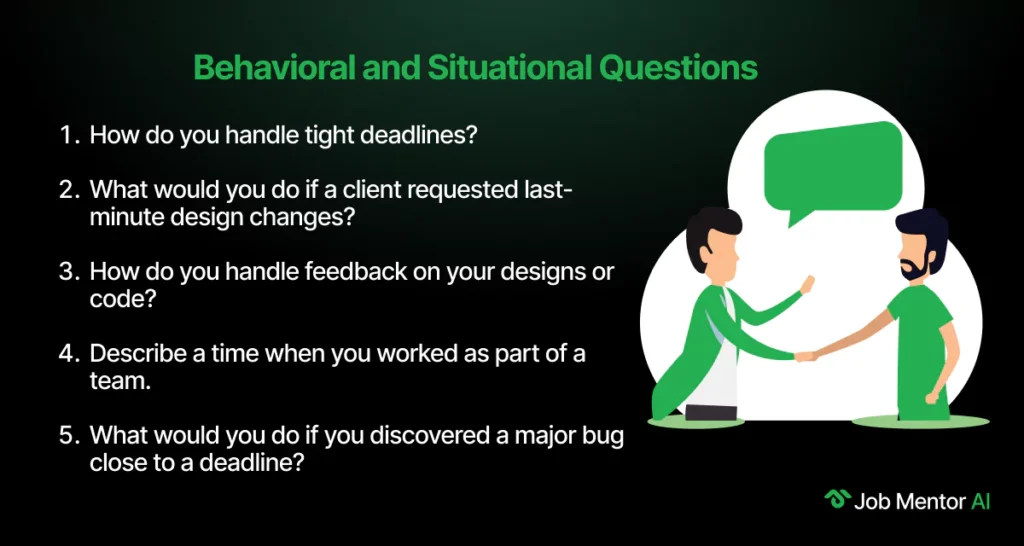
1. How do you handle tight deadlines?
What Interviewers Want:
Time management skills and ability to prioritize tasks.
Strong Answer:
“I prioritize tasks by breaking them into smaller, manageable parts and focusing on the most critical ones first. I use tools like Trello or a to-do list to track progress and ensure nothing is overlooked. If needed, I communicate with the team to adjust priorities or ask for support to meet the deadline.”
Poor Answer:
“I work quickly and focus on finishing the most important tasks on time.”
2. What would you do if a client requested last-minute design changes?
What Interviewers Want:
Flexibility and effective communication skills.
Strong Answer:
“I’d first clarify the changes and assess their impact on the timeline. If feasible, I’d implement them promptly while ensuring quality. If not, I’d communicate with the client to prioritize essential changes and propose a realistic timeline for the remaining updates.”
Poor Answer:
“I’d try to make the changes as quickly as possible before the deadline.”
3. How do you handle feedback on your designs or code?
What Interviewers Want:
A willingness to improve and collaborate.
Strong Answer:
“I see feedback as an opportunity to improve. I listen carefully to understand the suggestions, ask questions for clarification if needed, and make adjustments while keeping the overall goals in mind. For example, when a colleague suggested optimizing a layout for accessibility, I implemented their suggestions and learned new techniques in the process.”
Poor Answer:
“I listen to feedback and make the necessary changes to improve my work.”
4. Describe a time when you worked as part of a team.
What Interviewers Want:
Examples of teamwork and clear communication.
Strong Answer:
“In a group project to build a portfolio website, I collaborated with a designer and a backend developer. My role was to implement the frontend using React. We held regular meetings to align progress, and I coordinated with the designer to ensure the layout matched the mockups while integrating APIs from the backend.”
Poor Answer:
“I worked on a team to build a website and focused on the frontend part.”
5. What would you do if you discovered a major bug close to a deadline?
What Interviewers Want:
Problem-solving under pressure and prioritization skills.
Strong Answer:
“I’d assess the bug’s severity and its impact on the project. If it’s critical, I’d prioritize fixing it immediately, even if it meant extra hours. I’d also inform the team and client about the issue and the steps I’m taking to resolve it. For minor bugs, I’d document them for a future update.”
Poor Answer:
“I’d fix the bug quickly and let the team know about it.”
6. Have you ever worked with a designer or backend developer? How did you collaborate?
What Interviewers Want:
Ability to work effectively in cross-functional teams.
Strong Answer:
“Yes, I collaborated with a designer to implement a landing page. We discussed the design specs in detail, and I provided feedback on feasibility. I also worked closely with a backend developer to integrate APIs for a dashboard, ensuring the data displayed correctly. Regular check-ins and clear communication were key to our success.”
Poor Answer:
“I worked with a designer to implement a design and with a backend developer to integrate APIs.”
7. What would you do if you had to learn a new tool quickly for a project?
What Interviewers Want:
Adaptability and eagerness to learn.
Strong Answer:
“I’d start by exploring the tool’s documentation and tutorials to understand the basics. Then, I’d practice with small examples to apply what I’ve learned. If needed, I’d seek advice from teammates or online forums. For example, I once had to learn Git during a project and quickly became comfortable with commits, branches, and pull requests within a week.”
Poor Answer:
“I’d learn the tool by reading the documentation and practicing with it until I understood it.”
Critical Thinking Web Designer Interview Questions
Critical thinking is very necessary for web designers. Web designers have to balance user needs and business goals. So, junior web designers during an interview should give answers that highlight their ability to make tough decisions whenever an ambiguous situation presents itself.
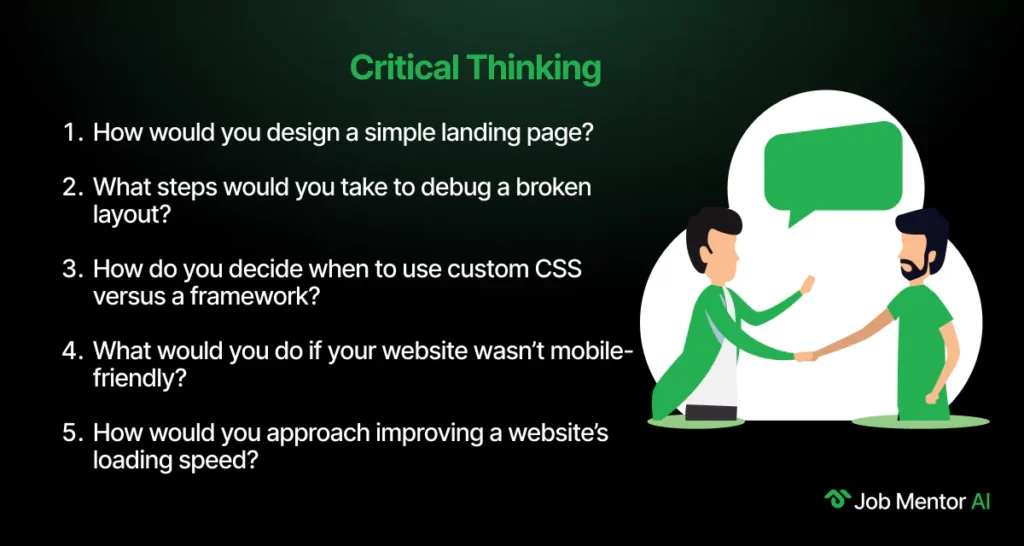
1. How would you design a simple landing page?
What Interviewers Want:
A clear thought process, creativity, and understanding of layout basics.
Strong Answer:
“I’d start by outlining the key sections, such as a hero banner, features section, testimonials, and a call-to-action. I’d use semantic HTML for structure and apply CSS for styling and layout. To ensure responsiveness, I’d use Flexbox or Grid and add media queries for different screen sizes. I’d also optimize for speed by minimizing images and using lightweight code.”
Poor Answer:
“I’d create a header, some sections, and a call-to-action using HTML and CSS.”
2. What steps would you take to debug a broken layout?
What Interviewers Want:
Logical debugging process using browser tools and CSS inspection.
Strong Answer:
“I’d use browser developer tools to inspect the layout and identify issues like incorrect styles, missing CSS files, or conflicting rules. I’d check the CSS for problems like improper values or missing properties. If the issue persists, I’d simplify the code to isolate the problem and test different solutions until it’s fixed.”
Poor Answer:
“I’d inspect the element in the browser tools and fix any issues with the CSS.”
3. How do you decide when to use custom CSS versus a framework?
What Interviewers Want:
Awareness of trade-offs between flexibility and efficiency.
Strong Answer:
“I’d use custom CSS for smaller projects or when I need full control over the design. For larger projects or those with tight deadlines, I’d use a framework like Bootstrap or Tailwind to save time and maintain consistency. The decision also depends on the complexity of the design and the team’s familiarity with the framework.”
Poor Answer:
“I’d use custom CSS for unique designs and a framework to speed up development.”
4. What would you do if your website wasn’t mobile-friendly?
What Interviewers Want:
A step-by-step plan to implement responsive design.
Strong Answer:
“I’d start by identifying the issues using browser developer tools and Google’s Mobile-Friendly Test. I’d apply media queries to adjust styles for smaller screens, use flexible units like percentages for layouts, and ensure buttons and text are optimized for touchscreens. I’d also test the site on multiple devices to confirm the fixes work.”
Poor Answer:
“I’d use media queries to fix the styles and test the site on different screen sizes.”
5. How would you approach improving a website’s loading speed?
What Interviewers Want:
Knowledge of optimizing assets, lazy loading, and reducing HTTP requests.
Strong Answer:
“I’d start by analyzing the site with tools like Google PageSpeed Insights to identify bottlenecks. Key optimizations would include compressing images, minifying CSS and JavaScript files, enabling lazy loading for media, and reducing HTTP requests by combining files. I’d also implement caching and use a Content Delivery Network (CDN) for faster content delivery.”
Poor Answer:
“I’d compress images, minimize files, and use caching to make the website faster.”
Performance-Based Interview Questions for Web Designers
Some performance based web designer interview questions are discussed below with thorough answers.

1. Can you create a simple webpage layout with HTML and CSS?
What Interviewers Want:
Basic coding ability and syntax knowledge.

2. How would you fetch and display data from an API?
What Interviewers Want:
Practical coding skills and understanding of asynchronous programming.

HTML Example:
Explanation: This function fetches data from an API, processes the JSON response, and dynamically updates the DOM.
3. Can you explain and debug a piece of given code?
What Interviewers Want:
Logical problem-solving and communication about the debugging process.
Broken Code:

Debugging Process:
- Identify the error: Check the console, which shows ReferenceError: Totla is not defined.
- Locate the issue: Notice the typo in the console.log statement.
- Fix the issue: Correct Totla to total.
- Test the function: Run the function with sample inputs to verify it works.
Fixed Code:

Strong Answer:
“I identified the typo in the console.log statement, corrected it, and confirmed the function works by testing it with sample inputs.”
Problem-Solving and Analytical Thinking in Web Designer Interview Questions
Explain your thought process in detail to showcase how you tackle technical difficulties during the development process. Give examples from previous projects where you faced and overcame such challenges.

1. What would you do if your design wasn’t user-friendly?
What Interviewers Want:
Ability to gather feedback, analyze, and improve the design.
Strong Answer:
“I’d gather feedback from users through surveys or usability testing to understand their pain points. I’d analyze the data and identify specific areas causing confusion or difficulty. Then, I’d iterate on the design, making changes to improve navigation, clarity, or usability, while testing again to ensure the improvements address the issues.”
Poor Answer:
“I’d ask for feedback and make changes to improve the design.”
2. How do you handle conflicting design feedback from clients and stakeholders?
What Interviewers Want:
Problem-solving and negotiation skills to find a balanced solution.
Strong Answer:
“I’d listen to both perspectives and ask clarifying questions to understand their concerns. I’d then use data or examples to demonstrate what aligns best with the project goals and user needs. If needed, I’d propose a compromise or test both options to determine which works better.”
Poor Answer:
“I’d try to balance the feedback and make changes to satisfy both sides.”
3. What steps would you take to improve a slow-loading website?
What Interviewers Want:
Awareness of design practices that optimize performance.
Strong Answer:
“I’d optimize images by compressing them and using modern formats like WebP. I’d minimize CSS, JavaScript, and HTML files and implement lazy loading for images and videos. Using a CDN to distribute content and enabling browser caching would also help reduce load times.”
Poor Answer:
“I’d compress images, minimize files, and use caching to make the site faster.”
4. How do you ensure a website design is accessible?
What Interviewers Want:
Practical knowledge of color contrast, font sizes, and alt text for images.
Strong Answer:
“I follow accessibility guidelines like WCAG to ensure proper color contrast and readable font sizes. I add alt text for images, use semantic HTML for structure, and ensure that all interactive elements are keyboard-navigable. I also test the site using screen readers and accessibility evaluation tools.”
Poor Answer:
“I make sure the colors and fonts are accessible and add alt text to images.”
5. What would you do if a user couldn’t navigate your website easily?
What Interviewers Want:
A focus on usability testing and iterative design improvements.
Strong Answer:
“I’d conduct usability testing to identify where users are struggling. I’d map out the user journey and look for areas with unclear navigation or unnecessary steps. I’d then simplify the layout, improve labeling, and add clear calls-to-action to guide users more effectively.”
Poor Answer:
“I’d test the website and make changes to make it easier to navigate.”
6. What would you do if a client wanted a feature you’ve never designed before?
What Interviewers Want:
Resourcefulness and willingness to learn.
Strong Answer:
“I’d research similar features and study best practices to understand the requirements. I’d also consult with the client to clarify their expectations and create wireframes or prototypes to ensure the design meets their needs. If needed, I’d seek advice from teammates or experts in that area.”
Poor Answer:
“I’d research the feature and try to design it based on what the client wants.”
7. How do you balance creativity with a client’s business goals?
What Interviewers Want:
An ability to align design solutions with the client’s objectives.
Strong Answer:
“I start by understanding the client’s objectives and target audience. Then, I brainstorm creative solutions that align with their goals while keeping the user’s experience in mind. For example, I once designed a visually appealing landing page that incorporated the client’s branding while optimizing for conversions by adding a clear call-to-action.”
Poor Answer:
“I try to keep the design creative while focusing on what the client wants to achieve.”
8. How would you fix inconsistent design elements on a site?
What Interviewers Want:
Awareness of creating and applying a consistent style guide.
Strong Answer:
“I’d create a style guide to define consistent design rules for colors, fonts, spacing, and components. I’d then audit the website to identify inconsistencies and update the elements to match the guide. Using reusable components in a design system can help maintain consistency across the site.”
Poor Answer:
“I’d go through the site and fix any inconsistencies in the design.”
9. What would you do if your design didn’t work well on mobile devices?
What Interviewers Want:
Problem-solving skills to address responsiveness issues.
Strong Answer:
“I’d use browser developer tools to identify issues and test the site on multiple devices. I’d adjust the design using media queries and ensure elements like buttons, images, and text scale properly. Additionally, I’d simplify the layout for smaller screens and prioritize touch-friendly navigation.”
Poor Answer:
“I’d fix the design with media queries and make it work better on mobile devices.”
10. How do you decide between multiple design ideas?
What Interviewers Want:
Logical reasoning and user-centered decision-making.
Strong Answer:
“I evaluate each idea based on user needs, client goals, and technical feasibility. I may create prototypes and conduct A/B testing to see which option resonates best with users. Ultimately, I choose the design that delivers the best user experience while meeting the project objectives.”
Poor Answer:
“I choose the idea that seems most suitable for the users and the project goals.”
Career Growth Web Designer Interview Questions
Before applying for any job, it’s essential to make sure your cover letter aligns with the job description and shows your potential for growth. Using an AI Cover Letter Generator can help you create a tailored, job-specific letter that showcases your strengths. Employers often look for long-term potential, so it’s important that your cover letter and interview responses reflect your motivation and alignment with the company’s values.
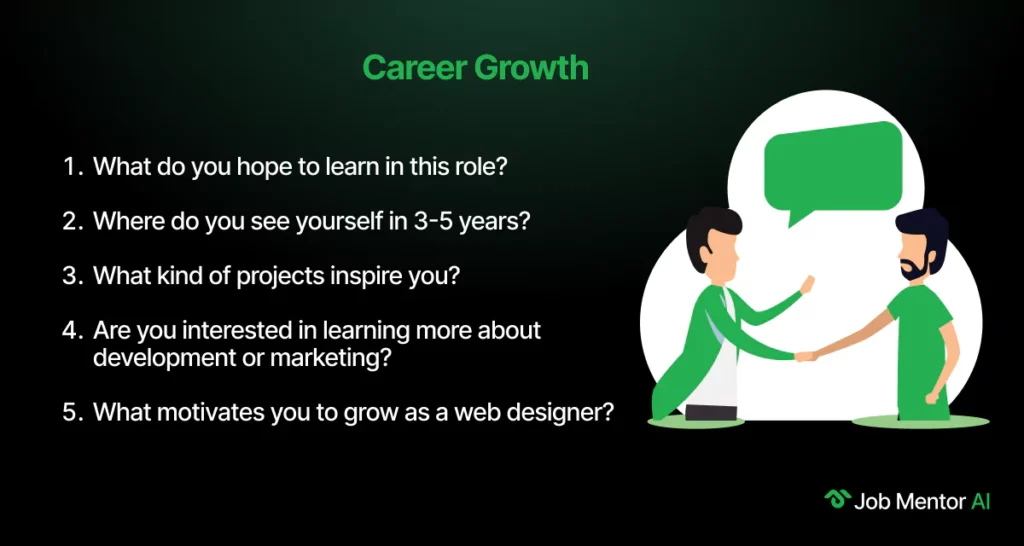
1. What do you hope to learn in this role?
What Interviewers Want:
A clear desire to improve design skills and grow professionally.
Strong Answer:
“I hope to deepen my understanding of user experience design by working on real-world projects and collaborating with experienced team members. I also want to improve my skills in responsive design and learn how to incorporate user feedback effectively. Additionally, I’m excited to explore emerging trends and tools to stay ahead in the field.”
Poor Answer:
“I want to improve my design skills and learn from the team.”
2. Where do you see yourself in 3-5 years?
What Interviewers Want:
A vision of long-term growth in web design or related fields.
Strong Answer:
“In 3-5 years, I see myself as a skilled web designer with expertise in creating intuitive and visually appealing user interfaces. I’d like to take on larger, more complex projects and possibly mentor junior designers. I also hope to expand my knowledge into UX research and development to contribute more holistically to projects.”
Poor Answer:
“I want to become an experienced designer and work on bigger projects.”
3. What kind of projects inspire you?
What Interviewers Want:
Passion for creating innovative and impactful designs.
Strong Answer:
“I’m inspired by projects that have a meaningful impact on users, such as improving accessibility or solving complex problems through innovative design. For example, designing a platform that simplifies access to healthcare or education excites me because it combines creativity with purpose.”
Poor Answer:
“I like working on creative projects that make a difference for users.”
4. Are you interested in learning more about development or marketing?
What Interviewers Want:
Interest in complementary skills that enhance design expertise.
Strong Answer:
“Yes, I’m very interested in learning about development to better collaborate with developers and understand the technical limitations of my designs. I’m also curious about marketing strategies, as they provide insights into user behavior and can help me create designs that drive engagement and conversions.”
Poor Answer:
“I’m open to learning about development and marketing to improve my skills.”
5. What motivates you to grow as a web designer?
What Interviewers Want:
A genuine passion for design and a commitment to improvement.
Strong Answer:
“I’m motivated by the opportunity to solve real-world problems through design and the satisfaction of creating something both functional and beautiful. The fast-paced evolution of design tools and trends also drives me to continuously learn and adapt. Seeing my designs positively impact users keeps me excited about growing in this field.”
Poor Answer:
“I enjoy solving problems and learning new things, which motivates me to improve as a designer.”
Need Help Sharpening Your Interview Skills?
Enhance your interview performance with AI Interview Assistant an intuitive tool designed to help you practice common interview questions and receive valuable feedback. Explore our resource hub for additional tips and expert advice, offering tailored strategies to improve your responses. Whether you’re preparing for behavioral questions or want to build confidence, Job Mentor AI provides a personalized, supportive environment to help you succeed. Start practicing today and elevate your interview skills like never before.
Questions to Ask Employer as a Junior Web Designer
- What tools and platforms will I use in this role?
- What kind of projects will I work on?
- What opportunities are there for mentorship or growth?
- How do designers collaborate with other teams here?
- What are the next steps in the hiring process?
Junior Web Designer Interview Questions
Table of Contents
Recommended Resources
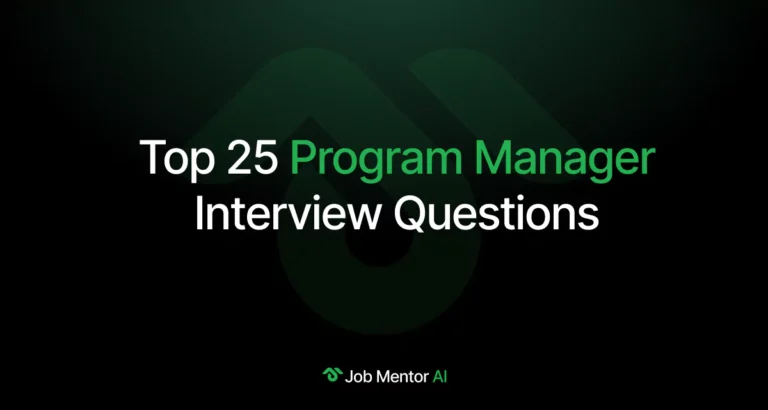
Top 25 Program Manager Interview Questions
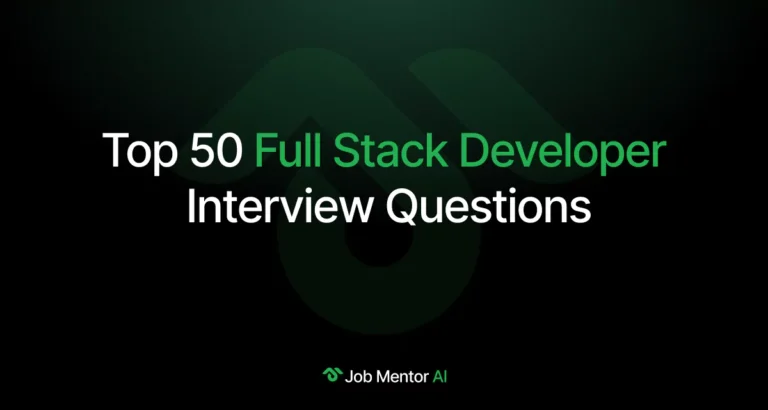
Fullstack Developer Interview Questions

Top 60 Azure DevOps Interview Questions 2025

Data Engineer Interview Questions

Top 30 Network Administrator Interview Questions You Must Prepare
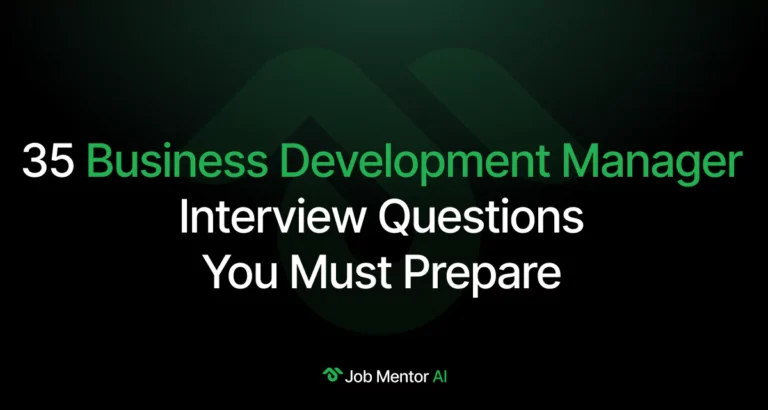
Business Development Manager


